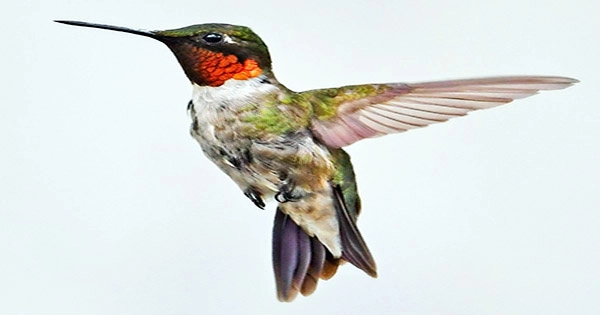According to a study published in eLife, ruby-throated hummingbirds employ the same energy-saving method to endure overnight fasts and create the fat stores they require to fuel long journeys.
The findings provide credence to a long-held concern among hummingbird researchers. They also reveal new information on the rules by which birds decide whether to preserve energy or store fat.
The Ruby-throated Hummingbird is a little hummingbird with a slender, slightly downcurved bill and short wings that don’t extend all the way to the tail when it sits. The back and crown are vivid emerald or golden-green, with gray-white underparts.
In low light, males have a beautiful iridescent red throat that seems dark. Ruby-throated Hummingbirds fly straight and quickly, but they can also halt in an instant, hover, and alter their position up, down, or backward with incredible precision. They frequently visit hummingbird feeders and tube-shaped flowers, which they guard against other birds.
Hummingbirds, especially ruby-throated, devour sweet nectar all day to fuel their quick wing motions that allow them to hover. To save energy during their nocturnal fasts, the birds can enter an energy-saving phase known as torpor, which involves lowering their body temperature and reducing their metabolism by up to 95%.
Ruby-throated Hummingbirds can be found in parks, gardens, and backyards, as well as open forests, forest borders, meadows, and grasslands. The bird breeds throughout the eastern United States, east of the 100th meridian, and in southern Canada, particularly Ontario, in the eastern and mixed deciduous and broadleaved forest. In winter, it is seen mostly in Mexico and Florida.

Our findings that hummingbirds can use torpor to cope with different energetic challenges throughout the annual cycle are important for understanding differences in how these and other migratory animals that don’t use torpor might respond to future environmental changes in food availability and temperature.
Kenneth Welch Jr.
“We wanted to know if hummingbirds use this same energy-saving mechanism to more quickly build the fat stores they’ll use to power their 5,000-kilometre migrations between their North American breeding grounds and Central American winter homes,” says first author Erich Eberts, a Ph.D. student at the Welch Lab, University of Toronto Scarborough, Ontario, Canada.
Eberts and his team measured daily changes in the body, fat, and lean masses of 16 ruby-throated hummingbirds during three periods: the breeding season, late summer when the birds prepare to migrate, and during the birds’ typical migration period to learn how and when they use this energy-saving strategy.
They also used respirometry to detect when the birds went into torpor by measuring their oxygen intake.
Hummingbirds kept lean body masses during the breeding season and only went into torpor when their fat stores dipped below 5% of their body mass. This ‘energy-emergency approach’ was typically used on nights when their energy supplies were low.
The 5 percent criteria for entering torpor is no longer used in late summer when the birds normally increase their body mass by 20% to maintain themselves over the long trip. Instead, they toss and turn more frequently, and their fat levels are higher. This permits them to preserve energy and fatten up even as the nights grow longer.
“We’ve shown that hummingbirds abandon the energy-emergency strategy in the late summer and start using torpor to accumulate the fat stores they need for migration,” Eberts explains.
The authors go on to say that learning more about this energy-saving method could be crucial for the survival of ruby-throated hummingbirds and other migratory bird species, which are under growing stress due to climate change and habitat loss.
“Our findings that hummingbirds can use torpor to cope with different energetic challenges throughout the annual cycle are important for understanding differences in how these and other migratory animals that don’t use torpor might respond to future environmental changes in food availability and temperature,” concludes Kenneth Welch Jr., Associate Professor and Acting Chair of the Department of Biological Sciences at the University of Toronto Scarborough, and co-author of the study alongside Christopher Guglielmo, Professor at the University of Western Ontario, Canada.
















